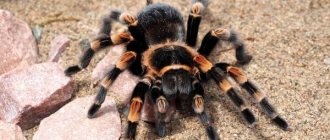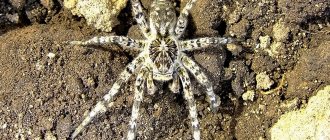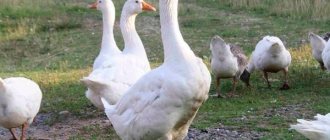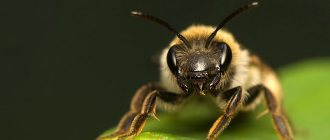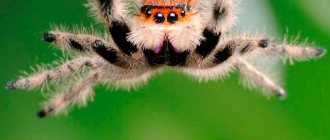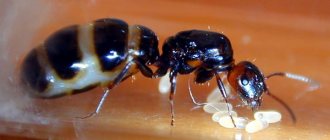The tarantula is definitely not the most pleasant representative of the animal kingdom, given that in addition to its peculiar appearance, it is also a poisonous insect. The name of this spider, “tarantula,” came to us from Renaissance Italy. In those distant times, there were many of these spiders in the cities of Italy and, as a result, many people were bitten by them. Because of the bite, the unfortunate people suffered from convulsive seizures; of course, these conditions could have been caused by other reasons, but then they were associated specifically with spider bites. And the largest number of people bitten was in the Italian city of Taranto, which gave the name to this spider - tarantula.
An interesting fact: to cure the consequences of a bite from this spider, medieval doctors prescribed dancing until you drop a special dance - the tarantella, which, by its name and history of origin, is also directly connected with the city of Taranto, and with the hero of our today's publication - the tarantula spider.
Origin of the species and description
Photo: Tarantula spider
The genus Lycosa comes from the wolf spider family. The name of the species originated in the Renaissance. In the past, Italian cities were infested with these arachnids, which is why many bites were reported, accompanied by convulsions. The disease was called tarantism. Most of the bites were recorded in the city of Taranto, where the name of the spider came from.
Interesting fact: To recover, medieval healers instructed patients to dance until they dropped the Italian tarantella dance, which also originated in Taranto, located in southern Italy. Doctors believed that only this would save those bitten from death. There is a version that all this was arranged for feasts hidden from the eyes of the authorities.
The genus belongs to the phylum arthropods and has 221 subspecies. The most famous of them is the Apulian tarantula. In the 15th century, its poison was believed to cause madness and a variety of epidemiological diseases. It has now been proven that the toxin has no effect on humans. The South Russian tarantula lives in Russia and Ukraine and is known for its black cap.
Interesting fact: The species Lycosa aragogi, found in Iran, is named after the huge spider Aragog from the books about the young wizard “Harry Potter”.
In many European languages, the word tarantula refers to tarantulas. This leads to confusion when translating texts from foreign languages, in particular from English. In modern biology, groups of tarantulas and tarantulas do not intersect. The former belong to araneomorphic spiders, the latter to mygalomorphic ones.
Name
In Russian and Ukrainian it is called the South Russian tarantula (due to the distribution of the species in the south of Russia). Popularly called “mizgir”.
In other languages, it is often named after the territories where it is found: Romanian (Romanian românească), Tatar (Czech tatarský), Ukrainian (Polish ukraińska), Dzungarian and the like.
Female
Types of tarantulas
The genus Tarantula includes more than 200 species of spiders. Among them, the most famous are the following types.
Apulian tarantula (true tarantula)
It has a size of 7 cm. Females of this species are characterized by a combined coloration, consisting of a dark cephalothorax outlined by a light thin stripe and a red abdomen decorated with several transverse stripes framed by a red and white border. The male tarantula has a more modest, monochromatic appearance. Apulian tarantulas live mainly on mountain slopes in vertical burrows up to 0.6 m deep, which can be detected by a characteristic roll of dried leaves framing the entrance.
Unlike many of their fellow spiders, true tarantulas do not spin webs. During the day they prefer to hide in a hole, and at twilight and night hours they leave their shelter to hunt insects. On the eve of winter cold, poisonous spiders seal the entrance to their home using dry grass intertwined with cobwebs and hibernate.
The life expectancy of a tarantula in natural conditions after the onset of puberty does not exceed 2-3 years for males and 4-5 years for females. Apulian tarantulas live in countries such as Italy and Algeria, Spain and Libya, Portugal and Morocco, Egypt and Sudan.
South Russian tarantula or Mizgir
It is an inhabitant of fields, gardens and orchards, slopes of ravines and river banks. The habitat of the tarantula is the steppe, semi-desert and desert zones of Russia, Belarus, Ukraine and the countries of Central Asia. The size of the Mizgir tarantula rarely exceeds 35 mm in females and 25 mm in males. The color of the spider depends on the color of the soil in the area where it lives, so there are light brown, black-brown or reddish specimens with spots of various shapes and sizes.
A characteristic feature of this type of spider is the presence of a dark “cap” on its head. The depth of the burrows in which poisonous tarantulas live often reaches 0.5 m. The entrance to the burrow is protected by a low wall consisting of excavated soil and reinforced with grass and plant remains. During the rain or molting process, the entrance to the shelter is sealed with earth and cobwebs.
Like all members of the wolf spider family, Mizgiri do not weave webs to catch prey, but hunt insects while sitting in or near a burrow. In anticipation of the onset of cold weather, South Russian tarantulas descend to the very bottom of the hole, having previously sealed the entrance to it with a thick earthen plug. South Russian tarantulas live no more than 3-5 years. The life expectancy of females is longer than that of males.
Tarantula Lycosa narbonensis
Reaches a size of 5-6 cm. The body of the poisonous spider is brown-black, the legs are long, covered with hairs. Tarantulas are found in Italy, France, Macedonia, Malta, Spain, the countries of the former Yugoslavia and northern Africa.
Spanish tarantula
Lives in southern Europe and northern African countries. Tarantulas eat small invertebrates and also practice cannibalism. Previously, the spider was considered a subspecies of the Apulian tarantula, but since 2013 it has been considered as a separate species.
Brazilian tarantula
It lives in the countries of South America: Brazil, Uruguay, Paraguay, in the northern, northeastern and central parts of Argentina. Like other members of the genus, the Brazilian tarantula has 8 eyes arranged in 3 rows. In the bottom row there are 4 small eyes, a little higher there are 2 large eyes, and 2 more are on the sides of the head. The size of the tarantula is approximately 3 cm excluding the legs. The color of the spider is dark brown. There is a light longitudinal stripe on the head, which acquires a yellowish tint in the upper part of the back. In the center of the upper part of the abdomen, the stripe takes the shape of an arrow that points forward. The lower part of the abdomen of a poisonous spider is black. The chelicerae are reddish-brown in color. Tarantulas feed on crickets, cockroaches and other spiders.
Tarantula Lycosa poliostoma
Lives in South American countries: Brazil, Uruguay, Argentina, Paraguay. It lives in gardens, steppes, meadows, during the day it hides among the grass or in trees, in stones or holes, and is nocturnal. Like other species, these tarantulas eat crickets, cockroaches, small insects and other spiders. The length of the spider, excluding the legs, is 3 cm. The color of the tarantula is gray-brown or dark brown. There is a light longitudinal stripe on the head. In the upper part of the abdomen, the strip takes the shape of an arrow that points forward. The lower part of the tarantula's abdomen is black. The color of the chelicerae is light, which distinguishes this type of spider from the Brazilian tarantula. Females are larger than males, but females have shorter legs.
Tarantula Lycosa leuckarti
This is a gray-brown spider. The length of males reaches 0.9 cm, females - 1.2 cm (excluding paws). This species of tarantula lives in Australia.
Tarantula Lycosa coelestis
Lives in Japan and Taiwan. The length of females reaches 13-18 mm. The male tarantula measures 11-13 mm. The body color is brown, there are 2 longitudinal dark stripes on the back. The inner side of the tarantula's abdomen is black, for which the spider received the name "black-bellied tarantula."
Description, structure, characteristics
Tarantula belongs to the phylum of arthropods, class of arachnids, order of spiders, family of spiders -
wolves are the genus of tarantulas themselves. Like many arthropods, the body of the tarantula is covered with small hairs. In general, the tarantula’s body structure has two main parts: the cephalothorax and abdomen.
At the top of the tarantula's head there are as many as eight eyes, with 4 of them located in a straight line, and the remaining larger eyes located in a trapezoid. Thanks to this arrangement of the eyes, tarantulas have a viewing angle of 360 degrees. Also, in addition to well-developed vision, these spiders also have an excellent sense of smell, with which they can sense potential prey at a considerable distance (for these insects).
The size of the tarantula varies from 2.5 to 10 cm. The span of the legs of this spider can reach 30 cm. Like many insects in the world, female tarantulas are usually several times larger than males.
Throughout their lives, tarantulas change the peculiar chitinous “armor” that covers their body several times. The tarantula also has four pairs of long, hairy legs, allowing the spider to move comfortably across loose or even water surfaces.
The mandibles of the tarantula are covered with poisonous canals, they are very strong and serve the spider as a means of defense and attack.
The color of the tarantula is usually brown, gray or black. Although sometimes there are representatives of these spiders that have lighter colors.
Where did the word "tarantula" come from?
There is no exact information about the etymology of the name of this genus of spiders. However, most researchers believe that its origins go back to the Renaissance. Then, many convulsive seizures that occur in humans were associated with spider bites, which lived in large numbers in the vicinity of Italian cities, including in the city of Taranto in southern Italy, where the largest number of bites was noted. It was thanks to this city that the spiders got their name. It is noteworthy that to cure a disease, medieval doctors prescribed dancing a special dance to exhaustion - the tarantella.
What to do if bitten by a tarantula?
The toxicity of tarantulas depends on many factors - their species, gender, age, time of year. For example, in April spiders are not particularly active. They just woke up and are practically in no danger.
There are fewer spider bites, and they are not very toxic. In mid-May, spiders begin to lay their eggs and become more active. Aggression awakens in them and along with this toxicity increases.
The beginning of June is characterized by a 3-fold increase in toxicity. It is at this time that spiders mate and migrate. This is the most dangerous time. Only in September does the toxicity of tarantulas decrease.
In essence, the poison of these invertebrates does not pose a great danger to humans. The only exceptions are people prone to allergies and small children.
A tarantula bite may be accompanied by local pain, redness of the skin at the site of the bite, swelling, general malaise, drowsiness, and increased temperature. For some, these symptoms include dizziness and nausea.
Apulian tarantula
The bite site is under no circumstances cauterized. The bite should not be cut. This can lead to infection. Scratching is also contraindicated. You must first wash the bite with antibacterial or regular soap, followed by an antiseptic.
Applying cold can reduce the pain comparatively. A large amount of water will help quickly remove toxic substances. And taking antihistamines will relieve allergies. In case of sudden deterioration in health or bite of small children, it is better to call an ambulance.
What is the difference between a tarantula and a tarantula?
Tarantulas are often confused with the tarantula spider, so to put an end to this, here are the differences between them:
- Tarantulas differ from tarantulas in the structure of their chelicerae. In tarantulas they move in a parallel direction, in tarantulas in a medal direction towards each other.
- Also, these spiders belong to different families, tarantulas belong to the family of wolf spiders, tarantulas belong to the family of tarantulas.
What do tarantulas eat?
As you probably already guessed, tarantulas are notorious predators, their food consists of numerous small insects and amphibians: caterpillars, mole crickets, crickets, beetles, cockroaches, small frogs, etc. Tarantulas guard their prey from a hiding place, and then quickly attack. Having attacked, they paralyze the prey with their poison, which subsequently turns its insides into a nutritious liquid, then the tarantula sucks it out like a “cocktail”.
The process of absorption of food by a tarantula can last several days, but in general they are not very voracious and can do without food for a long time, as long as they have access to water.
Clean
South Russian tarantulas are hunters. Their food is everything that runs along the surface of the soil, but does not greatly exceed the size of the spider itself: beetles, flies, mosquitoes, midges, caterpillars, worms, ground beetles. But the tarantulas themselves are lucky, few people like to feast on them. Except for wasps and birds.
Mizgiri, like all arachnids, have extraintestinal digestion. They attack the victim, once within jumping distance, and approach silently and unnoticed. The poison is deftly injected along with the contents of the midgut, immobilizing the prey. Then the spider sucks the liquid from the victim’s body, like a cocktail from a straw. And what he doesn’t finish, he throws away away from himself. Sort of a neat guy.
Another feature of the South Russian tarantula is that it does not weave a web for hunting. It is needed only to protect the home - it seals the entrance from unwanted guests. The spider lives in a hole up to 50 cm deep. It spends time in it during the day, and from it it tracks down unwary living creatures. Mizgir rarely goes far from the hole, he does not like to be active much and is poorly oriented in space.
Social structure and reproduction
Photo: Poisonous tarantula spider
The period of sexual activity occurs in the last month of summer. The male weaves a web, after which he begins to rub his belly against it. This provokes ejaculation of seminal fluid, which flows onto the web. The male plunges his pedipalps into it, which absorb sperm and become ready for fertilization.
Next comes the stage of searching for a female. Having found a suitable candidate, the male emits vibrations with his abdomen and performs ritual dances, which attracts females. They lure out hiding females by tapping their paws on the ground. If the partner reciprocates, the spider inserts its pedipalps into her cloaca and fertilization occurs.
Then the male quickly retreats so as not to become food for his chosen one. The female weaves a cocoon in the hole in which she lays eggs. Their number can reach 50-2000 pieces at a time. The female carries the offspring on herself for another 40-50 days. The hatched babies move from the mother's abdomen to the back and remain there until they are able to hunt on their own.
The spiderlings grow quickly and soon begin to taste the prey caught by their mother. After the first moult they scatter. By 2-3 years, predators become sexually mature. During this period, arthropods lose their instinct of self-preservation and are easy to meet in broad daylight.
Report No. 2
A tarantula is a spider that uses its web only to arrange the walls in its burrow where in the future it will begin hunting or its female will lay eggs, which is considered dangerous for people, but in fact represents a real danger only for animals.
Where does the tarantula live?
The tarantula lives and builds burrows for caring for offspring and hunting, in dry ones without a single hint of moisture; when it finds this place, it begins to build a burrow about 60 centimeters deep, the walls of which are then reinforced with its cobwebs. At night, the spider leaves its burrow into the desert or steppe and begins to hunt.
What does a spider eat?
The spider most often begins its hunt at night; it either sits in a burrow waiting for prey or moves freely around the area. Now the prey is already nearby, the tarantula attacks and injects poison into the body, thereby either paralyzing or killing the prey. Most often, the tarantula feeds on not too large insects, such as mole crickets, ground beetles, crickets, cockroaches, beetles, caterpillars and others.
Types of tarantulas.
In total, about 221 species of tarantulas are known, for example:
- Spanish tarantula
- Brazilian tarantula
These are just a few, they differ only slightly in appearance, but are approximately similar in characteristics, but the most popular species are considered to be the South Russian tarantula and the Apulian tarantula, which reaches approximately 6 - 7 centimeters in length.
Reproduction.
Towards the end of summer, the female tarantula tries to find a suitable hole, when she finds it, she lays eggs and wraps them in a web, which she carries with her, after the young tarantulas hatch, some of them remain in the female tarantula’s abdomen.
Bite.
In general, a tarantula’s bite is dangerous only for animals; humans are not in danger of anything fatal, and its bite in terms of pain can be compared to a hornet’s sting and at most can cause swelling, but nothing more. And the antidote to his poisonous saliva is contained in his hemolymph.
History of the name.
Where did this name come from? Once upon a time in the city of Toronto it was generally accepted that the bite of such a spider led to illness, a strange disease, Tarantism, and as people believed there was only one way to recover from a terrible, deadly disease - this was to perform a ritual by dancing the unusual dance Tarantella, but as it turned out later, everything These rituals took place not because of a fatal disease, which turned out to be false, but only in order to hold a feast, which the government did not approve of at that time, but after all this the name of the spider never changed.
2, 3, 4, 7 grade
Natural enemies of tarantula spiders
Photo: Black tarantula spider
The tarantula has quite a few enemies. The main culprits in the death of arthropods are birds, since they are part of the diet of birds. Wasps encroach on the life of arachnids, just as spiders do with their victims. They inject poison into the tarantula's body, paralyzing the predator.
They then lay eggs inside the spider. Parasites live and develop, after which they get out. Natural enemies include some types of ants and mantises, which are not at all picky about food and eat everything that moves. Frogs and lizards are not averse to eating tarantulas.
The most dangerous enemy is still the same spider. Arthropods tend to eat each other. A female, during the process of fertilization, can encroach on the life of a male individual, like a female praying mantis, or eat her offspring if she cannot trap some insect.
There is continuous hostility between tarantulas and mole crickets. Their habitats overlap. Mole crickets dig the soil, where spiders often climb. Sometimes individuals manage to escape. Wounded or molting arthropods usually become food for the enemy.
In general, the population suffers most in early spring. When lethargic and sleepy arachnids crawl out of their shelters, the mole cricket is right there. Sometimes they climb into spider holes and attack tarantulas with their forelimbs, delivering heavy blows. When the spider loses a lot of blood, the mole cricket eats it.
Is it possible to reproduce
Sexual maturity in females occurs 1.5-2 years later than in males. If for males this is 1.5-2 years, then for females it is 4-5 years. The mating period begins at the end of summer. After mating, the male usually dies, and the female begins to prepare for the winter. Female tarantulas lay eggs and place them in a silk cocoon, which is attached to the outside of the abdomen. “Gestation” lasts 40-50 days. During this period, under natural conditions, the female tries to be in the sun more often in order to speed up the incubation process, but at home it is worth increasing the temperature in the terrarium to +30...+32 °C.
A clutch can contain from 50 to 500 eggs. After the incubation period is completed, the little spiderlings remain with their mother for another month, sometimes covering her entire body. After the expiration of a month, the babies leave the female and begin to lead an adult lifestyle. There are cases when the female herself drives away the young or even eats some part of it, so the babies need to be weaned on time.
Well, now you have the necessary knowledge on how to properly keep a tarantula at home, let this knowledge be useful to you, and remember: we are responsible for those we have tamed.
If you are planning to have a tarantula as a pet, you should be well informed about them. These pets require special care. In this article we will talk about the needs of these spiders.
There are about 35,000 species of spiders known in the world. Of these, about 900 are tarantulas. This is a genus of large venomous araneomorph spiders from the wolf spider family (Lycosidae). The body length of large representatives reaches 3.5 cm.
They have a heavy body structure and eight eyes on the convex front of the body. They are all venomous to one degree or another and have a tendency to bite. The bites of some tarantulas are painful, reminiscent of a hornet sting and cause swelling
Keeping a tarantula at home
If you have decided that you want to have such an unusual companion at home, then you can be completely calm - caring for him requires a minimum of effort. For this reason, if you are a busy person, but want to get a little friend, you have made the right choice. Having provided him with the necessary living conditions at the very beginning of your friendship, you can assume that the most difficult thing is already behind you.
Typically, small terrariums serve as a home for arthropods indoors. A prerequisite for your comfortable living together will be the presence of a lid for the terrarium. After all, we must not forget for a second that this is still a spider. And he tends to weave a web, which can serve as a ladder from his house to yours, and also that this is a poisonous creature and its bite, although not fatal, is, nevertheless, not very pleasant.
It is also recommended to arrange his home so that he can sometimes retire. Natural materials, such as tree crowns or various branches, are best suited for constructing shelters. And you won’t have to spend money, and your student will feel almost like in their native lands.
The flooring should be prepared from moss, sand, earth and clay. We must remember that this spider is a hard worker and loves to build houses for himself, so the flooring layer should allow the terrarium inhabitant to dig at least a small hole for himself.
A necessary attribute in his house will be a container that will always be filled with clean drinking water and a small pool. It is in the pool that he will swim. After all, the most common cause of death of tarantulas is dehydration. To prevent such an unpleasant situation, it is also necessary to carry out regular spraying of its territory. The temperature in his “apartment” should always be within 24–28 degrees, and the air humidity should be at least 50%.
- Menu for the big-eyed pet. The diet of a domestic tarantula is not much different from this process in the wild. Its food list should include a variety of living creatures that fit the size of your pet arachnite, such as cockroaches, crickets, small worms and grasshoppers. The regularity of eating varies depending on the age category of your arthropod. If this is a young individual, then it needs to be fed twice a week, but if we are talking about an adult spider, then the optimal frequency of meals is once every 8–10 days. It is necessary to immediately remove any leftovers from your companion’s “table”. It would be a very good idea to feed your tenant with various vitamin complexes from time to time, which will have a very positive effect on his health, and, accordingly, on the duration of his life period.
- The right neighborhood. It is not recommended to place several individuals in one terrarium; this can not only provoke their aggression towards each other, but in a fit of anger they will simply eat each other.
- Dealing with a toxic friend. "Everything has its time!" - this saying, by the way, is perfect for tarantulas. After some time, he will get used to you and will not perceive you as an object that poses a threat to him. You should pick up this unique pet carefully and carefully, avoiding sudden movements.
Is it possible to reproduce
Sexual maturity in females occurs 1.5-2 years later than in males. If for males this is 1.5-2 years, then for females it is 4-5 years. The mating period begins at the end of summer. After mating, the male usually dies, and the female begins to prepare for the winter. Female tarantulas lay eggs and place them in a silk cocoon, which is attached to the outside of the abdomen. “Gestation” lasts 40-50 days. During this period, under natural conditions, the female tries to be in the sun more often in order to speed up the incubation process, but at home it is worth increasing the temperature in the terrarium to +30...+32 °C.
A clutch can contain from 50 to 500 eggs. After the incubation period is completed, the little spiderlings remain with their mother for another month, sometimes covering her entire body. After the expiration of a month, the babies leave the female and begin to lead an adult lifestyle. There are cases when the female herself drives away the young or even eats some part of it, so the babies need to be weaned on time.
Well, now you have the necessary knowledge on how to properly keep a tarantula at home, let this knowledge be useful to you, and remember: we are responsible for those we have tamed.
Among the wolf spiders there are interesting, surprising representatives. For some, their appearance is terrifying, while for others, on the contrary, they seem incredibly beautiful. Large araneomorphic venomous spiders called tarantulas
They are an incredibly beautiful furry creature, which in the old days was considered poisonous and dangerous to humans.
Tarantula tarantula
A lot has changed since then. It has been proven that tarantulas are not too dangerous for humanity, but this does not stop some people from looking at them with caution. Just the sight of it makes you shiver involuntarily, even in the photo of a tarantula.
Tarantula bite
although not fatal, it can cause some trouble. After it, the victim may experience a feverish state.
Sometimes, judging by numerous literary descriptions, the aggressive behavior of these spiders was noticed. But this does not mean that such behavior is characteristic of all their representatives.
Tarantula bite
In fact, they live more according to the law - “don’t touch me, and I won’t touch you.” And to a greater extent they can bite only for the purpose of self-defense. By the way, according to eyewitnesses, the bite of these spiders resembles a wasp bite. They do not produce such a large amount of toxins that could negatively affect the health of a person who has been bitten.
Danger
All types of tarantulas are poisonous. The poison lies in the glands located in the cephalothorax and opening at the top of the tentacles-mandibles, with which the spider pierces the skin of its prey in order to then suck it out. Tarantulas do not attack humans on their own, but if they are teased, especially females wearing an egg cocoon or having young spiders on them, jump up and can bite a person.
For humans, a tarantula bite is never fatal, but causes swelling and pain in the bitten area. In addition, sometimes the skin turns yellow and remains that way for quite a long time (up to 2 months). There is no reliable information about the fatal outcome for humans from a tarantula bite.
Bite and effect of poison on humans
The tarantula itself is unlikely to attack a person. But he can be forced to do this by the actions of the person himself, for example, if he accidentally touches a spider, the latter may bite in self-defense.
A tarantula bite is not dangerous for a healthy person, with the exception of children and people with allergic reactions, in such cases it is imperative to seek professional medical help.
Symptoms of a tarantula bite and their consequences may look like this:
- local pain at the site of the bite, redness and swelling.
- drowsiness, lethargy, general poor health.
- a sharp but short-term increase in temperature.
- in some cases there may be nausea and vomiting.
Population and species status
Photo: Tarantula spider
Tarantulas are most common in forest-steppe, steppe and desert areas. Their numbers are gradually decreasing every year, but over the past ten years, wolf spiders have managed to stop the process of population decline and even stabilize it. Climate warming has had a beneficial effect on this.
One of the main reasons for the decline in arthropod numbers is commercial activity. In third world countries, arachnids are caught in order to sell them for little money and earn food. In countries with less developed economies, there has been a significant decline in the number of tarantulas.
From 1995 to 2004 in the Republic of Tatarstan, the species was recorded in the Nizhnekamsk, Elabuga, Zelenodolsk, Tetyushsky, Chistopol, and Almetyevsk regions, where its appearance was recorded from 3 to 10 times. Mostly, individuals are found alone.
Tropical forests are being cut down at a significant rate due to population growth. In Bolivia and Brazil, artisanal methods of gold and diamond mining are used, which destroys the soil. Water is pumped underground, as a result of which the integrity of the earth's surface is damaged. This, in turn, leads to negative consequences for the existence of the animal world.
Features of character and lifestyle
Photo: Tarantula spider
Tarantulas, unlike their counterparts, do not spin webs. They are active hunters and prefer to catch prey on their own. They use webs as traps to find out about a beetle or other insect running past. Weaves can warn of approaching danger.
The arthropods sit in the hole all day, and in the evening they emerge from the shelter to hunt. With the onset of cold weather, they seal the entrance to their cave and hibernate. Among the individuals there are real long-livers. Some subspecies can exist up to 30 years. The main part of the species lives on average 3-10 years. Females have a longer lifespan.
The growth of the spider does not stop at any stage of development. Therefore, their exoskeleton changes several times as they grow older. This allows the animal to regrow lost limbs. With the next moult, the leg will grow back, but will be much smaller than the rest of the limbs. After the next molt, it will reach normal size.
Interesting fact: Spiders mostly move on the ground, but sometimes they climb trees or other objects. Tarantulas have claws on their paws, which they, like cats, extend to have better grip on the surface on which they climb.
Tarantula Spider Conservation
Photo: Tarantula spider from the Red Book
The South Russian tarantula, which has the second name Mizgir, is listed in the Red Book of the Republic of Tatarstan and classified as category 3 of species that are reducing their numbers; in the Red Book of Udmurtia, where it was assigned category 4 with an uncertain status; Red Data Book of the Nizhny Novgorod Region in category B3.
Limiting factors are active human agricultural activity, natural enemies, destruction of characteristic habitats, loss of dry grass, changes in groundwater levels, trampling of wet biotopes, military operations in semi-deserts, and an increase in plowed areas.
The species is protected by the Zhigulevsky Nature Reserve, the Prisursky Nature Reserve on the territory of the Batyrevsky site and the Samarskaya Luka National Park. Conservation measures include educational work among residents to limit the catching of arthropods. There are farms for breeding tarantulas in Mexico.
Conservation measures that need to be implemented include identifying the arachnid's natural habitats and providing the protection required for the species. The dry grass has stopped falling in the spring. Organization of NP "Zavolzhye". Restriction or cessation of economic activity, limitation of chemicals for spraying plants, suspension of livestock grazing.
The tarantula spider is not an aggressive animal. He will prefer to escape than attack a person. An attack can be provoked by the actions of people who touch the spider or get too close to the hole. Fortunately, the bite of a predator is comparable to a bee sting, and the blood of the spider itself can best neutralize the effect of the poison.
Black Tarantula - Grammostola pulchra
Black tarantula photo
The description is as follows: this tarantula tarantula is 6-7 cm in size, black in color and densely covered with hairs. Lives in Brazil. Prefers a fairly humid environment (about 60-70 mm per month) and a temperature of 18-25 C°. When the cold season comes, the black tarantula digs a hole in the ground, where it spends the winter. As a pet tarantula, this is an excellent option, as it is quite calm and not fast. Moreover, this is a long-lived spider, it lives up to 20 years. Due to their slow development, black tarantulas become adults at 6-7 years of age. They feed on insects. This spider is kept in terrariums filled with substrate with different shelters and recesses. Their mating is peaceful and calm. After mating, the female lays eggs in a web cocoon, where there are about 100 spider embryos. The spider guards the cocoon and carries it with her. The black tarantula is not dangerous, it is quite calm, but if handled incorrectly, it can bite. The symptoms of its bite are similar to those of a bee or hornet sting.
Buy a tarantula
This can be done through free classifieds sites, social networks or specialized forums where lovers of large spiders gather.
An individual of the South Russian tarantula is offered to be purchased for 1 thousand . rubles and send it to you in another city with opportunity. Before purchasing, do not forget to find out how responsible the seller of arthropods is, and only then transfer money. Watching a tarantula is undoubtedly very interesting, but do not relax - it is, after all, poisonous and bites without much thought.
How to get rid of tarantulas in the garden
Start fighting these arthropods as soon as you notice their burrows in your area. Tarantulas make deep underground passages, dig holes and thereby reduce soil productivity.
Walk through all the beds, checking the secluded places under the leaves and in the depressions in the soil where the tarantulas could lay their eggs. Collect and burn all cocoons found. Spray the rows with boric acid or lime.
If there are few tarantula burrows in your area, place baits in the form of lumps of plasticine attached to threads like a sinker and lower them into the burrows. Spiders will certainly cling to these baits, then they can be collected and destroyed.
As a repellent plant, plant peppermint bushes in your area. If possible, drive stakes into the area and put wind rattles on them. The vibration from the rotating ratchets will be transmitted underground along the stakes, and the tarantulas will leave your area.
Important! If you plan to breed these arthropods, place the babies and mother immediately after they reach one month of age. During this period, the female ceases to recognize her cubs and often eats a significant part of them.
tarantula spider: KEEPING AND CARE AT HOME, PHOTO, BREEDING
LIZARD: DESCRIPTION, PHOTO, REPRODUCTION, SPECIES, FOOD, LIFESTYLE
CHAMELEON: LIFESTYLE, HABITAT, PHOTO, SPECIES, REPRODUCTION, HUNTING
IGUANA: CARE AND MAINTENANCE AT HOME, PHOTO, DESCRIPTION
Spreading
Distributed in deserts, semi-deserts, steppes and forest-steppes from Austria and Hungary to the Caspian Sea, Central Asia, Southern Siberia, the Russian Far East and Northwestern China. Also lives in Turkey, the Middle East, and Egypt. In Ukraine, it is distributed throughout almost the entire territory, except for the main part of the Carpathians (however, it is found in the Volcanic Massif). Occasionally found further north, especially along river banks with sandy soils.
